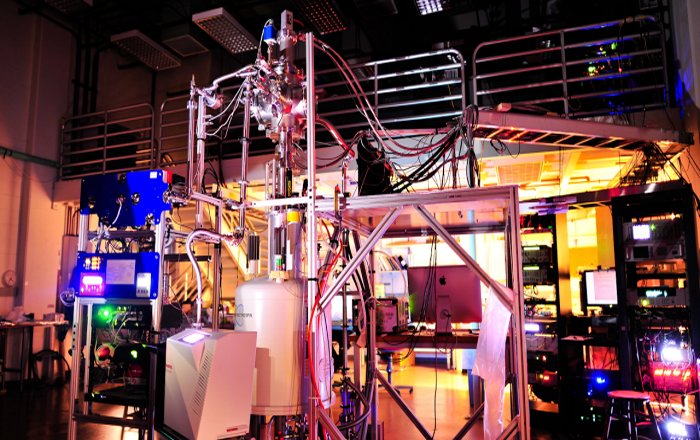Eddie Gonzales Jr. – MessageToEagle.com – Neutrinos are ubiquitous elementary particles that interact only very weakly with normal matter.
While the Project 8 group in Mainz is focusing on the development of atomic sources, the first prototypes of the experiment have been built in Seattle the USA. The device shown here is the second built by the collaboration and the first to use tritium. (photo/©: Alec Lindman / Project 8)
Therefore, they usually penetrate it unhindered and are therefore also called ghost particles. Nevertheless, neutrinos play a predominant role in the early universe.
In order to fully explain how our universe evolved, we need above all to know their mass. But so far, it has not been possible to determine this mass.
The international Project 8 collaboration wants to change this with its new experiment. For the first time, Project 8 is using a completely new technology to determine the neutrino mass, the so-called “Cyclotron Radiation Emission Spectroscopy” – CRES for short. In a recent publication in the renowned journal Physical Review Letters, the Project 8 collaboration has now been able to show that the CRES method is indeed suitable for determining the neutrino mass and has already set an upper limit for this fundamental quantity in a first measurement – an important milestone has thus been reached.
From Johannes Gutenberg University Mainz (JGU), the research groups of Prof. Dr. Martin Fertl and Prof. Dr. Sebastian Böser are involved, both researchers at the Cluster of Excellence PRISMA+. Dr. Christine Claessens, former PhD student of Sebastian Böser and now postdoc at the University of Washington in Seattle (USA), made a crucial contribution to the current publication as part of her PhD thesis.
Electrons as the key to neutrino mass
The Project 8 experiment uses the beta decay of radioactive tritium to track neutrino mass. Tritium is a heavy relative of hydrogen – a so-called isotope. It is unstable and consists of one proton and two neutrons. By converting one of these neutrons into a proton, tritium decays to helium while emitting an electron and an antineutrino. “And here’s the kicker,” says Martin Fertl, in a press release.
“Since neutrinos and their antiparticles have no electric charge, they are very difficult to detect. Therefore, we don’t even try to detect them. Instead, we measure the energy of the resulting electrons via their orbital frequency in a magnetic field. Based on the shape of the energy spectrum of the electrons, we then determine the neutrino mass, or set an upper limit on that mass in this way.”
Very precise measurement of electron energy is necessary
To obtain reliable results, the energy of the electrons must be measured extremely precisely. This is because the resulting (anti)neutrino is incredibly light, at least 500,000 times lighter than an electron. “When neutrinos and electrons are produced simultaneously, the neutrino mass has only a tiny effect on the electron’s motion. And we want to see this small effect,” explains Sebastian Böser. The method that makes this possible is called “Cyclotron Radiation Emission Spectroscopy” (CRES). It registers the microwave radiation emitted by the nascent electrons when they are forced into a circular path in a magnetic field. The frequency of the emitted radiation can be determined extremely precisely and then the mass of the neutrino can be inferred from the electron energy.
To make this work, Christine Claessens has made a decisive experimental contribution: “As part of my doctoral thesis, I developed, among other things, an event detection system consisting of a real-time trigger and an offline event reconstruction.
This system searches for the characteristic CRES features in the continuously digitized and processed radio frequency signal. Reconstruction of the start frequency of each electron event enables high-precision recording of a tritium decay spectrum.” On this basis, Christine Claessens succeeded in analyzing the first tritium spectrum recorded with CRES with respect to systematic uncertainties – and thus in calculating a first upper limit for the neutrino mass with this new technology, which has now found its way into the latest publication.
There, the Project 8 collaboration specifically reports 3,770 tritium-beta decay events that were registered over a period of 82 days in a sample cell the size of a single pea. The sample cell is cooled to very low temperatures and placed in a magnetic field that causes the escaping electrons to travel in a circular path long enough for the detectors to register a microwave signal.
Crucially, no false signals or background events are registered that could be mistaken for or mask the “real signal”. “The resulting first-time determination of the upper limit for the neutrino mass with a purely frequency-based measurement technique is a very promising result, since we can measure frequencies very accurately nowadays,” Sebastian Böser and Martin Fertl conclude.
Next steps are already underway
After the successful proof of principle, the next step is ready: For the final experiment, the researchers need individual tritium atoms, which they create from the fission of tritium molecules. This is tricky because tritium, like hydrogen, prefers to form molecules. Developing such a source – first for atomic hydrogen and later for atomic tritium – is an important contribution of the Mainz team.
At the moment the Project 8 collaboration, which includes members from ten research institutions worldwide, is working on testing designs for scaling up the experiment from a pea-sized sample chamber to one a thousand times larger. This will allow far more beta decay events to be registered. At the end of a multi-year research and development program, the Project 8 experiment should eventually surpass the sensitivity of previous experiments – such as the current KATRIN experiment – to provide a value for neutrino mass for the first time.
Written by Eddie Gonzales Jr. – MessageToEagle.com Staff







